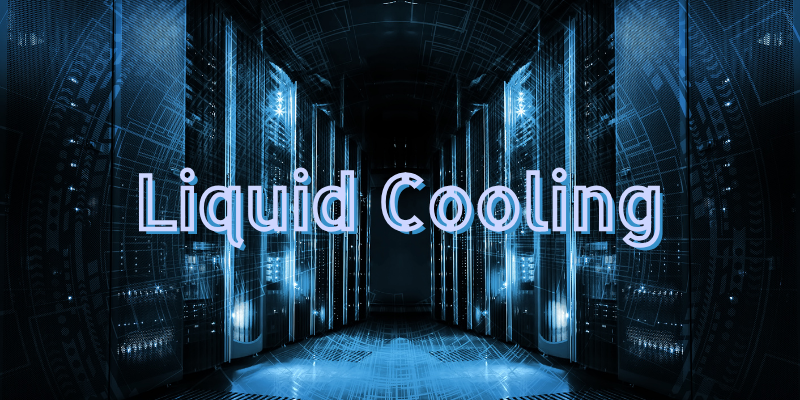- Home
- Blog
- IDC Services
- Liquid Cooling Technology Explained: The Future of High-Density Data Centers and AI Infrastructure
Liquid Cooling Technology Explained: The Future of High-Density Data Centers and AI Infrastructure

As AI computing, cloud platforms, and 5G edge computing continue to evolve rapidly, the thermal density generated by server equipment is reaching unprecedented levels. Traditional air cooling methods, based on fans and air conditioning, are struggling to keep up due to efficiency limitations and excessive energy consumption. To support high-performance computing (HPC), large-scale model training, and high-density racks, liquid cooling is rapidly emerging as the mainstream innovation in data center cooling.
.png)
Limitations of Traditional Air Cooling
Air cooling, using data hall HVAC systems and internal server fans, has been the dominant approach for over a decade. However, it now faces several challenges:
- Insufficient heat dissipation: When server heat density exceeds 10 kW per rack, air cooling often fails to remove heat quickly enough, increasing the risk of thermal throttling or hardware failure.
- High energy consumption and PUE: Cooling systems are power-intensive, often pushing the data center's Power Usage Effectiveness (PUE) above 1.5.
- Complex airflow and space management: Cold and hot aisle separation and airflow control require precise infrastructure planning with limited flexibility.
- Noise and maintenance overhead: Fans and cooling units generate high noise levels and require frequent maintenance.
Key Advantages of Liquid Cooling
Liquid cooling utilizes high thermal conductivity fluids (e.g., water, dielectric oil, or engineered coolants) to absorb and transport heat from IT hardware. Compared to air, liquids have significantly higher heat capacity and conductivity, offering the following benefits:
- Superior thermal transfer efficiency: Liquids dissipate heat much more effectively, reducing the temperature of heat-generating components quickly.
- Lower PUE: Liquid cooling can reduce PUE to as low as 1.2 or even 1.05, improving overall energy efficiency.
- Support for high-density computing: Single racks can support compute densities of 20–50 kW or more.
- Reduced noise and HVAC dependency: Fully enclosed liquid systems eliminate the need for loud fans.
- Improved hardware stability and lifespan: Minimizes thermal fluctuations, thereby extending server longevity.
.png)
Liquid Cooling Types and Coolant Selection
Liquid cooling systems vary by their heat transfer structures and coolant types. The three major architectures are:
1. Cold Plate / Direct-to-Chip (D2C) Liquid Cooling
Metal cold plates are directly attached to high-heat components such as CPUs and GPUs, with coolant circulating through the plates to absorb heat.
- Coolant: Typically deionized water or treated coolants
- Ideal for: High-performance cloud servers, AI training platforms
- Advantages: Modular deployment, easy maintenance, high compatibility with existing rack infrastructure
2. Rear-Door / In-Rack Liquid Cooling
Heat exchanger modules are mounted on the rear or side of the rack, capturing exhaust heat and transferring it via liquid loops.
- Coolant: Primarily water-based; requires sealed plumbing systems
- Ideal for: Retrofitting traditional data centers, phased liquid cooling adoption
- Advantages: Low deployment barrier, no need to modify existing server structures
3. Immersion Cooling
Entire servers are submerged in specially formulated dielectric fluids, either in single-phase (liquid only) or two-phase (liquid to vapor) systems.
- Coolant: Dielectric oils or fluorocarbon-based fluids (oil cooling is most common)
- Ideal for: AI supercomputing clusters, edge computing, high-temperature environments
- Advantages: Uniform cooling, significant energy savings, high space efficiency
4. Water vs. Oil: Roles of Coolants in Liquid Cooling
Common liquid cooling mediums include:
- Water cooling: Uses deionized water or additive-enhanced fluids. It offers excellent heat transfer performance but is electrically conductive, requiring well-sealed systems. Commonly used in cold plate and rear-door systems.
- Oil cooling: Employs dielectric oil in immersion systems to fully envelop server components. It enables extreme heat dissipation but involves higher infrastructure and maintenance costs.
While “water cooling” and “oil cooling” are often discussed together, they represent different subsystems suited to distinct application scenarios. They are not fundamental categories of liquid cooling but rather medium-specific implementations.
5. Global Deployment Trends and Use Cases
As generative AI, HPC workloads, and large-scale training models accelerate, server thermal densities are reaching 30–70 kW per rack or more. Liquid cooling has moved from experimental to mainstream, as major hyperscalers and colocation providers adopt cold plate, immersion, and modular solutions for improved energy and water efficiency (WUE).
Industry Examples:
- Google: Has fully adopted cold plate liquid cooling since TPU v3, significantly improving heat transfer and system availability.
- Microsoft: Implements two-phase immersion cooling in AI data centers and is pioneering “zero evaporation” water cooling systems to reduce resource consumption.
- NVIDIA & Meta: Developed high-density liquid cooling for platforms like GB200, enabling up to 72 GPUs per rack with major efficiency gains. Meta also introduced custom liquid-cooled AI cabinets such as "Catalina."
- Equinix & Digital Realty: Promoting standardized liquid-cooled racks and modular liquid cooling services to accelerate data center transformation worldwide.
According to the Uptime Institute, over 30% of new data centers are expected to adopt liquid cooling technologies by 2026, making it a cornerstone of next-generation AI infrastructure.
As server power consumption and sustainability demands rise, liquid cooling is no longer just a technological upgrade. It’s a strategic pillar for future-ready data centers. Whether you're a cloud provider, ISP, or edge infrastructure operator, adopting liquid cooling has become essential to meeting the performance and efficiency requirements of tomorrow’s digital landscape.
Article Classification
Recent Articles
- Introduction to AI Chatbots: NLP, Deep Learning, and Application Scenarios
- Security Threats in the Generative AI Era: Prompt Injection, Data Leakage, and Protection Strategies
- The Future of Live Streaming: AI, Real-Time Translation, and Metaverse Concerts
- What is a CDN? Industry Applications and Acceleration Benefits
- 5 Practical AI Tools to Boost Work Efficiency: Essential Digital Assistants for Smarter Work
